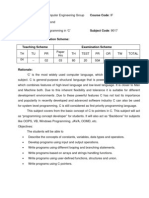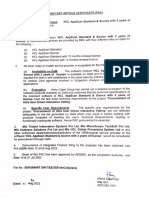CMP 103.3 Programming in C (3-0-3)
Uploaded by
HeroCMP 103.3 Programming in C (3-0-3)
Uploaded by
HeroCMP 103.
3 Programming in C (3-0-3)
Evaluation:
Theory Practical Total
Sessional 30 20 50
Final 50 - 50
Total 80 20 100
Course Objectives:
The object of this course is to acquaint the students with the basic principles of programming and development of
software systems. It encompasses the use of programming systems to achieve specified goals, identification of
useful programming abstractions or paradigms, the development of formal models of programs, the formalization of
programming language semantics, the specification of program, the verification of programs, etc. the thrust is to
identify and clarify concepts that apply in many programming contexts:
Chapter Content Hrs.
1 Introduction 3
History of computing and computers, programming, block diagram of computer, generation
of computer, types of computer, software, Programming Languages, Traditional and
structured programming concept
2 Programming logic 5
Problems solving(understanding of problems, feasibility and requirement analysis) Design
(flow Chart & Algorithm), program coding (execution, translator), testing and debugging,
Implementation, evaluation and Maintenance of programs, documentation
3 Variables and data types 3
Constants and variables, Variable declaration, Variable Types, Simple input/output
function, Operators
4 Control Structures 6
Introduction, types of control statements- sequential, branching- if, else, else-if and switch
statements, case, break and continue statements; looping- for loop, while loop, do—while
loop, nested loop, goto statement
5 Arrays and Strings 6
Introduction to arrays, initialization of arrays, multidimensional arrays, String, function
related to the strings
6 Functions 6
Introduction, returning a value from a function, sending a value to a function, Arguments,
parsing arrays and structure, External variables, storage classes, pre-processor directives,
C libraries, macros, header files and prototyping
Pokhara University/Faculty of Science & Technology/Revised Syllabus-2012/Programming in C 1
7 Pointers 7
Definition pointers for arrays, returning multiple values form functions using pointers.
Pointer arithmetic, pointer for strings, double indirection, pointer to arrays, Memory
allocation-malloc and calloc
8 Structure and Unions 5
Definition of Structure, Nested type Structure, Arrays of Structure, Structure and Pointers,
Unions, self-referential structure
9 Files and File Handling 4
Operating a file in different modes (Real, Write, Append), Creating a file in different modes
(Read, Write, Append)
Laboratory:
Laboratory work at an initial stage will emphasize on the verification of programming concepts learned
in class and use of loops, functions, pointers, structures and unions. Final project of 10 hours will be
assigned to the students which will help students to put together most of the programming concepts
developed in earlier exercises.
Textbooks:
1. Programming with C, Byran Gottfried
2. C Programming, Balagurusami
References
1. A book on C by A L Kely and Ira Pohl
2. The C Programming Language by Kerighan, Brain and Dennis Ritchie
3. Depth in C, Shreevastav
Pokhara University/Faculty of Science & Technology/Revised Syllabus-2012/Programming in C 2
You might also like
- 104 Computer Programming & Programming Methodology (CPPM)No ratings yet104 Computer Programming & Programming Methodology (CPPM)3 pages
- PROGRAMMING IN C Syllabus Sage UniversityNo ratings yetPROGRAMMING IN C Syllabus Sage University3 pages
- Course Objectives:: Teaching Computer Concept and Programming To Medical DoctorsNo ratings yetCourse Objectives:: Teaching Computer Concept and Programming To Medical Doctors3 pages
- CST - Draft Syllabus of 3rd Semester - 06122022No ratings yetCST - Draft Syllabus of 3rd Semester - 0612202222 pages
- CSA02 C Programming Syllabus 20200504081112No ratings yetCSA02 C Programming Syllabus 202005040811122 pages
- IT-104 Programming Fundamental Course OutlineNo ratings yetIT-104 Programming Fundamental Course Outline8 pages
- B.Sc. 1 Semester Computer Science Syllabus Under CBCSNo ratings yetB.Sc. 1 Semester Computer Science Syllabus Under CBCS9 pages
- Basic Programming and Data Structure (C)No ratings yetBasic Programming and Data Structure (C)8 pages
- Youngest Entrepreneurs of India-Shravan and Sanjay KumaranNo ratings yetYoungest Entrepreneurs of India-Shravan and Sanjay Kumaran3 pages
- Numbers From 1 To 100 - Problem DescriptionNo ratings yetNumbers From 1 To 100 - Problem Description5 pages
- University of Lucknow: Internet GeneratedNo ratings yetUniversity of Lucknow: Internet Generated1 page
- Base II Clearing VML Developer HandbookNo ratings yetBase II Clearing VML Developer Handbook78 pages
- Godot from Zero to Proficiency (Foundations): A step-by-step guide to create your game with Godot First Edition Felicia All Chapters Instant Download100% (1)Godot from Zero to Proficiency (Foundations): A step-by-step guide to create your game with Godot First Edition Felicia All Chapters Instant Download65 pages
- Project "Procurement of Infra User Driven Interactive Vetting" Are Not ReflectedNo ratings yetProject "Procurement of Infra User Driven Interactive Vetting" Are Not Reflected1 page
- UAE Government API Guidelines-First VersionNo ratings yetUAE Government API Guidelines-First Version69 pages
- WAP Via CSD Settings For LG 500, 601: For Postpaid Enter Gprsmtnlmum For Prepaid Enter GprsppsmumNo ratings yetWAP Via CSD Settings For LG 500, 601: For Postpaid Enter Gprsmtnlmum For Prepaid Enter Gprsppsmum15 pages
- Unicast Routing Protocols: Rip, Ospf, and BGPNo ratings yetUnicast Routing Protocols: Rip, Ospf, and BGP82 pages
- General Keyboard Shortcuts: To... Use This ShortcutNo ratings yetGeneral Keyboard Shortcuts: To... Use This Shortcut4 pages
- Sub Station Surveillance System: Engineering DepartmentNo ratings yetSub Station Surveillance System: Engineering Department6 pages
- Information Security Policy Final Goerge Washington UnversityNo ratings yetInformation Security Policy Final Goerge Washington Unversity7 pages

























































































